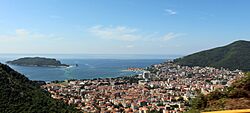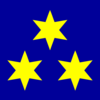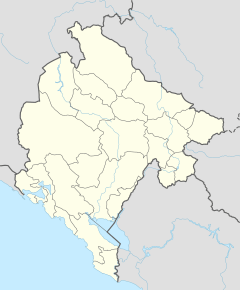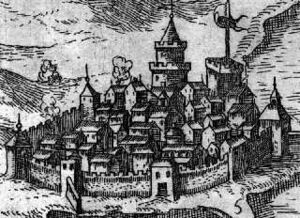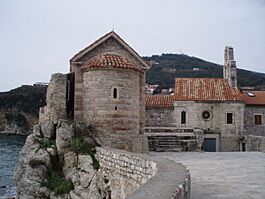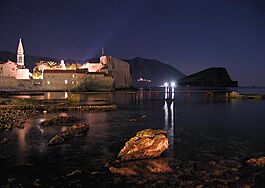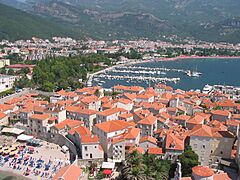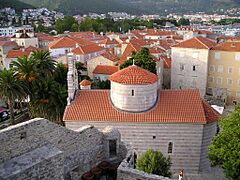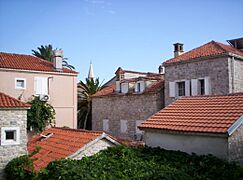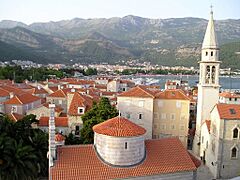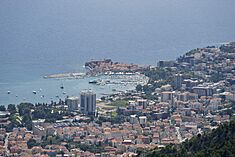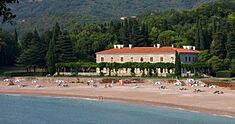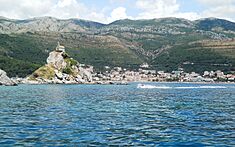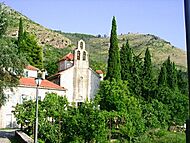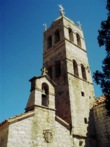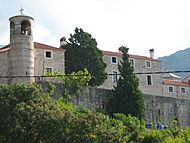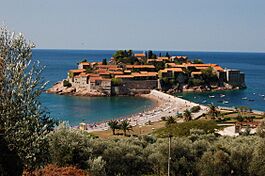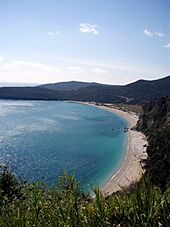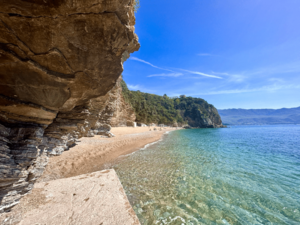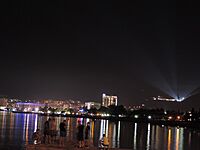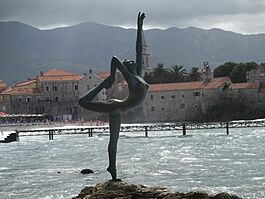Budva facts for kids
Quick facts for kids
Budva
Будва
|
|||
|---|---|---|---|
|
Town and municipality
|
|||
|
Budva panoramic view, Dancer statue in front of Old Town, Sveti Stefan island, Bečići and Budva Old Town
|
|||
|
|||
| Country | |||
| Municipality | |||
| Settlements | 33 | ||
| Area | |||
| • Town and municipality | 4.2 km2 (1.6 sq mi) | ||
| • Metro | 122 km2 (47 sq mi) | ||
| Elevation | 3 m (10 ft) | ||
| Population
(2023)
|
|||
| • Rank | 6th in Montenegro | ||
| • Urban | 17,479 |
||
| • Rural | 9,188 |
||
| • Municipality | 26,667 |
||
| Time zone | UTC+1 (CET) | ||
| • Summer (DST) | UTC+2 (CEST) | ||
| Postal code |
85310
|
||
| Area code | +382 33 | ||
| ISO 3166-2 code | ME-05 | ||
| Car plates | BD | ||
| Climate | Csa | ||
| Website | budva.me | ||
Budva is a beautiful town located on the coast of Montenegro. It's a very popular spot for tourists, known for its old walled city, lovely sandy beaches, and fun nightlife. Budva is super old, about 2,500 years old, making it one of the oldest places along the Adriatic Sea. Around 19,000 people live here, and it's the main town in the Budva area.
Contents
What's in a Name?
The town of Budva has been called different names throughout history. In Serbian, it's called Будва or Budva. The Italians and Latin speakers called it Budua. In Albanian, it's also Budua, and in ancient Greek, it was known as Bouthoe.
Budva's Long History
Legend says that Budva was founded by a hero named Cadmus. He was exiled from his home in Greece and found a new place to live here with his wife.
The first records of Budva go back to the 5th century BC. It was first part of a state called Illyria. Around the 6th century BC, ancient Greeks came and set up a trading post. Later, in the 2nd century BC, Budva became part of the huge Roman Empire. When the Roman Empire split, Budva was right on the border, which shaped its history and culture.
In the 6th century, Budva was part of the Byzantine Empire. Over the next two centuries, Slavs and Avars arrived and mixed with the local Roman people. In 841, Muslim Saracens attacked and damaged the area.
In the early Middle Ages, different local kings and nobles ruled Budva. Around the year 1200, it became an important religious center for the Roman Catholic Church.
The Venetians ruled Budva for almost 400 years, from 1420 to 1797. They built strong walls to protect the town from the Ottomans. For a short time in the 1570s, the Ottomans did take control, but it was soon returned to the Venetians. Many people in Budva spoke the Venetian language back then.
After the Venetians, Budva was ruled by the Habsburg monarchy (Austria). During the Napoleonic Wars, Montenegrin forces and Russia took control briefly. But then France took over, and finally, the Austrian Empire ruled for about 100 years.
After World War I in 1918, Budva became part of the Kingdom of Yugoslavia. During World War II, it was taken over by Italy. Budva was finally freed in 1944 and became part of Socialist Republic of Montenegro, which was part of Socialist Federal Republic of Yugoslavia.
A big earthquake hit Budva in 1979. Much of the old town was destroyed, but amazing work was done to rebuild almost everything exactly as it was. Today, you can barely see any damage.
Montenegro became an independent country in 2006, and Budva quickly became its main tourist spot. Recently, in 2022, many people from Ukraine, Russia, and Turkey moved to Budva, making its population grow even more.
Who Lives in Budva?
Budva is the main town in the Budva area, which includes nearby places like Bečići and Petrovac. The whole area has about 19,218 people. The town of Budva itself has about 13,338 residents.
Most people in Budva are Montenegrins or Serbs. There are also smaller groups of Russians, Croats, and others.
Most people in Budva follow the Eastern Orthodox Christian faith. There are also people who follow Islam, Catholicism, and other religions.
Exploring Budva's Cityscape
The Historic Old Town
Budva's Old Town sits on a rocky piece of land. It's believed that people lived here even before the ancient Greeks arrived. Most of the city walls and buildings you see today were built when the Venetians ruled.
The entire Old Town is surrounded by strong stone walls. These walls have towers, openings for defense, and fortified gates, just like many medieval cities.
There used to be gates on all sides of the walled city. The main entrance today is the Porta di Terra Ferma, which leads to the main street, Njegoševa Street. There are also other gates facing the marina and a small one near Ričardova glava beach.
The streets inside the Old Town are mostly straight but also have winding paths and small squares. Today, no cars are allowed inside the walls; it's only for people walking.
The town's citadel (a strong fortress) is at the southern tip. It was built and rebuilt over many years. Its walls are connected to the rest of the city walls. Inside the citadel, you can see old Austrian army buildings and the ruins of the Santa Maria de Castello church.
North of the citadel is a large public square with all of the Old Town's churches. These include St. Ivan Church (from the 17th century), Santa Maria in Punta Church (from 840 AD), St Sava Orthodox Church (12th century), and The Holy Trinity Orthodox church (1804).
The Old Town was badly damaged in the 1979 earthquake. But it was carefully rebuilt over eight years, and now you can hardly tell. Today, it's a huge attraction for tourists, especially in summer. Its narrow streets are full of restaurants, cafes, pubs, and shops.
Beyond the Old Town Walls
For most of its history, Budva stayed within its old walls. But in the 20th century, as tourism grew, the town started to expand. Hotels began to appear near the Old Town and along Slovenska beach. These included the famous Avala hotel and the Slovenska plaža complex. This growth was well-planned at first.
However, some parts of Budva grew very quickly and without much planning. This happened because of high demand for land and a lack of strict rules. This led to many new buildings, narrow streets, and sometimes not enough parking or good infrastructure. Even so, Budva continues to be a popular place to visit.
Tourism in Budva
Tourism is the most important part of Budva's economy. It's the most popular tourist spot in Montenegro. In 2013, Budva had over 668,000 visitors, which was almost half of all tourists in Montenegro!
While Budva has a long history and a beautiful Old Town, it's mostly known as a lively beach resort. It has a fun atmosphere and a very active nightlife.
Beautiful Beaches
Mogren Beach is one of the most famous and beautiful beaches in Budva. It's located under cliffs and is divided into two parts. You can reach it from the Old Town by a path along the cliffs.
Other city beaches include the small Ričardova Glava Beach and Pizana Beach, both near the Old Town. There's also the long Slovenska plaža (Slav beach), which stretches for about 1.6 kilometers.
Many other amazing beaches are found outside the city. Jaz Beach is a big beach west of Budva, often used for concerts and festivals. The resort town of Bečići has a long sandy beach, just southeast of Budva.
Further south, you'll find many small beaches and towns that are more fancy and exclusive. This includes the famous Sveti Stefan island, which used to be a fishing village. The area around Sveti Stefan and Pržno, including the Miločer resort, is considered the most exclusive part of the Montenegrin coast.
Sveti Nikola Island is right across Budva bay from the Old Town. You can take a water taxi to the island and enjoy its beaches.
Fun Nightlife
Budva is famous for its nightlife in the eastern Adriatic region. Dance clubs started appearing in the 1980s. In the 1990s and 2000s, many open-air clubs opened along the sea promenade. The Old Town and its promenade are full of bars, pubs, and restaurants. Two big clubs, Top Hill and Trocadero, are very popular.
Other Attractions
Budva hosts the Adriatic Fair, which is the only special exhibition center in Montenegro. It holds many trade shows throughout the year, including a car show every autumn.
Many hotels in Budva have casinos, making gambling tourism popular. The Maestral hotel and casino in Pržno are especially well-known. The 2006 James Bond movie Casino Royale was partly set in a fictional casino in Montenegro, which helped make Budva more famous for gambling.
Budva's marina, located north of the Old Town, is great for nautical tourism. You'll see many luxury yachts there in the summer. Budva has also hosted boat shows and even a powerboat championship.
Culture and Events
One of the most important cultural events in Budva is Theatre City (Budva Grad Teatar). Started in 1987, this festival happens every July and August. The entire Old Town becomes an outdoor stage for theater, music, literature, and art performances.
Another event was the Pjesma Mediterana ("Song of the Mediterranean"), a pop music festival held from 1992 to 2010. It was similar to the Sanremo Music Festival, with a competition for new songs. It attracted performers from the former Yugoslavia.
In 2014, the Sea Dance Festival started at Budva's Jaz Beach. It's a spin-off of the famous Exit festival and is now an annual event. Jaz Beach became well-known for concerts after The Rolling Stones played there in 2007, attracting about 35,000 people. Madonna also performed there in 2008 for 47,000 fans.
The Budva Carnival is a three-day celebration held every year in late April or early May. It started in 2003 and has become very popular.
The Budva city museum has interesting exhibits about the area's history and culture. There's also a memorial home for Stefan Mitrov Ljubiša, a famous writer from Budva.
Budva has a special place in the history of Montenegrin movies. It was home to Zeta Film, the main film company from the Yugoslav era. This company made many movies. In 2015, a new movie theater with four screens opened in the TQ Plaza shopping mall.
The city has also been a filming location for international movies. The 1964 film The Long Ships was shot in Budva. A large prop from the movie, a cracked bell, is still displayed in front of the Old Town walls. More recently, the popular TV series Budva na pjenu od mora (Budva, on the sea foam) was filmed here.
Learning in Budva
Budva has two elementary schools and one high school. In 2009, the city started the Knowledge Academy (Akademija Znanja). This place aims to be a university center and offer higher education in Budva. It also houses the city library and a private Business and Tourism faculty.
Sports in Budva
FK Mogren was the most popular football (soccer) club in Budva, founded in 1920. They won the Montenegrin championship twice. However, the club stopped playing in 2017. OFK Petrovac is another important football team from the nearby town of Petrovac.
Volleyball is also very popular in Budva. The Budvanska Rivijera volleyball team has been very successful. The Mediteranski sportski centar (Mediterranean sports center) is the main indoor sports venue in Budva. It's home to the volleyball team and the RK Budvanska Rivijera handball team. The town also has a basketball team, KK Mogren, and a water polo team, VK Budva.
Water polo is a common sport along the Montenegrin coast. VK Budva is the city's water polo team.
Paragliding is a fun summer activity in Budva. The high hills provide amazing views for paragliders.
Getting Around Budva
Budva is connected to other parts of Montenegro by highways. You can reach Budva from Podgorica, the capital, in about 60 kilometers.
The Adriatic Highway connects Budva to other coastal towns in Montenegro, stretching from Ulcinj in the south to Herceg Novi in the north, and on to Croatia.
Tivat Airport is about 20 kilometers away. It has regular flights to Belgrade and Moscow, and many seasonal flights in summer. Podgorica Airport is about 65 kilometers away and has flights to many European cities all year.
For getting around Budva itself, there are Mediteran Express buses. They run between the city center and Sveti Stefan, serving many parts of Budva and nearby small towns.
The closest train station is Sutomore, about 30 kilometers from Budva.
Famous People from Budva
- Cristoforo Ivanovich - A historian of opera and a composer from the 17th century.
- Visarion Ljubiša - A Serbian Orthodox Metropolitan Bishop of Montenegro in the late 1800s.
Budva's Sister Cities
Budva is connected with many cities around the world as "sister cities." This helps them share culture and ideas.
 Banská Bystrica, Slovakia
Banská Bystrica, Slovakia Belgrade, Serbia
Belgrade, Serbia Bijeljina, Bosnia and Herzegovina
Bijeljina, Bosnia and Herzegovina Celje, Slovenia
Celje, Slovenia Čukarica (Belgrade), Serbia
Čukarica (Belgrade), Serbia Eastern AO (Moscow), Russia
Eastern AO (Moscow), Russia Kamnik, Slovenia
Kamnik, Slovenia Kyiv, Ukraine
Kyiv, Ukraine Laktaši, Bosnia and Herzegovina
Laktaši, Bosnia and Herzegovina Makarska, Croatia
Makarska, Croatia Novi Sad, Serbia
Novi Sad, Serbia Ohrid, North Macedonia
Ohrid, North Macedonia Pakrac, Croatia
Pakrac, Croatia Petacciato, Italy
Petacciato, Italy Petropavlovsk-Kamchatsky, Moscow, Russia
Petropavlovsk-Kamchatsky, Moscow, Russia Prague 4 (Prague), Czech Republic
Prague 4 (Prague), Czech Republic Rimini, Italy
Rimini, Italy Stari Grad (Sarajevo), Bosnia and Herzegovina
Stari Grad (Sarajevo), Bosnia and Herzegovina Valašské Meziříčí, Czech Republic
Valašské Meziříčí, Czech Republic Velika Plana, Serbia
Velika Plana, Serbia Vrnjačka Banja, Serbia
Vrnjačka Banja, Serbia West Palm Beach, United States
West Palm Beach, United States Yalova, Turkey
Yalova, Turkey Zigong, China
Zigong, China
See also
 In Spanish: Budva para niños
In Spanish: Budva para niños


